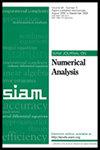高阶稀疏pic方法:分析与数值研究
IF 2.9
2区 数学
Q1 MATHEMATICS, APPLIED
引用次数: 0
摘要
SIAM数值分析杂志,63卷,第3期,1281-1314页,2025年6月。摘要。嵌入稀疏网格的粒子单元(PIC)方法最近被引入,以降低PIC近似中固有的统计噪声。在稀疏pic方法中,通过在粗糙网格层次上重建网格数量,从近似中滤除数值噪声。这一过程引入了数值近似精度的显著增益,相对于网格单元中的平均粒子数,这个参数控制数值噪声,但也引入了方法精度相对于网格分辨率的轻微差异。在以前的研究中,这个问题是通过仔细调整组成稀疏网格层次的网格来解决的,以定义数值噪声增益和网格误差损失之间的权衡。目前的工作致力于提高稀疏pic方法在网格分辨率方面的精度,与以前的成就相反,在不降低统计噪声方面的增益的情况下。提出了一种改进的误差估计方法。它允许人们控制数值粒子的数量,从而在由标准或稀疏pic方法进行的近似中获得可比较的统计噪声(从而评估方法的真正优点)。本文章由计算机程序翻译,如有差异,请以英文原文为准。
High-Order Sparse-PIC Methods: Analysis and Numerical Investigations
SIAM Journal on Numerical Analysis, Volume 63, Issue 3, Page 1281-1314, June 2025.
Abstract. Particle-in-cell (PIC) methods embedding sparse grids have been recently introduced to decrease the statistical noise inherent to PIC approximations. In sparse-PIC methods, the numerical noise is filtered out from the approximation thanks to a reconstruction of the grid quantities on a hierarchy of coarse meshes. This procedure introduces a significant gain in the precision of the numerical approximation with respect to the mean number of particles in a grid cell, this parameter controlling the numerical noise, but also introduces a slight discrepancy of the method precision with respect to the mesh resolution. In previous studies, this issue is addressed by a careful tuning of the grids composing the sparse grid hierarchy, to define a trade-off between the gain in the numerical noise and the loss in the grid error. The present work is dedicated to improving the precision of sparse-PIC methods with respect to the mesh resolution and, contrary to the previous achievements, without deteriorating the gains with respect to the statistical noise. A refined error estimate is proposed. It permits one to control the number of numerical particles to obtain a comparable statistical noise in the approximation carried out by either a standard or a sparse-PIC method (and thus assess the true merits of the methods).
Abstract. Particle-in-cell (PIC) methods embedding sparse grids have been recently introduced to decrease the statistical noise inherent to PIC approximations. In sparse-PIC methods, the numerical noise is filtered out from the approximation thanks to a reconstruction of the grid quantities on a hierarchy of coarse meshes. This procedure introduces a significant gain in the precision of the numerical approximation with respect to the mean number of particles in a grid cell, this parameter controlling the numerical noise, but also introduces a slight discrepancy of the method precision with respect to the mesh resolution. In previous studies, this issue is addressed by a careful tuning of the grids composing the sparse grid hierarchy, to define a trade-off between the gain in the numerical noise and the loss in the grid error. The present work is dedicated to improving the precision of sparse-PIC methods with respect to the mesh resolution and, contrary to the previous achievements, without deteriorating the gains with respect to the statistical noise. A refined error estimate is proposed. It permits one to control the number of numerical particles to obtain a comparable statistical noise in the approximation carried out by either a standard or a sparse-PIC method (and thus assess the true merits of the methods).
求助全文
通过发布文献求助,成功后即可免费获取论文全文。
去求助
来源期刊
CiteScore
4.80
自引率
6.90%
发文量
110
审稿时长
4-8 weeks
期刊介绍:
SIAM Journal on Numerical Analysis (SINUM) contains research articles on the development and analysis of numerical methods. Topics include the rigorous study of convergence of algorithms, their accuracy, their stability, and their computational complexity. Also included are results in mathematical analysis that contribute to algorithm analysis, and computational results that demonstrate algorithm behavior and applicability.

 求助内容:
求助内容: 应助结果提醒方式:
应助结果提醒方式:


